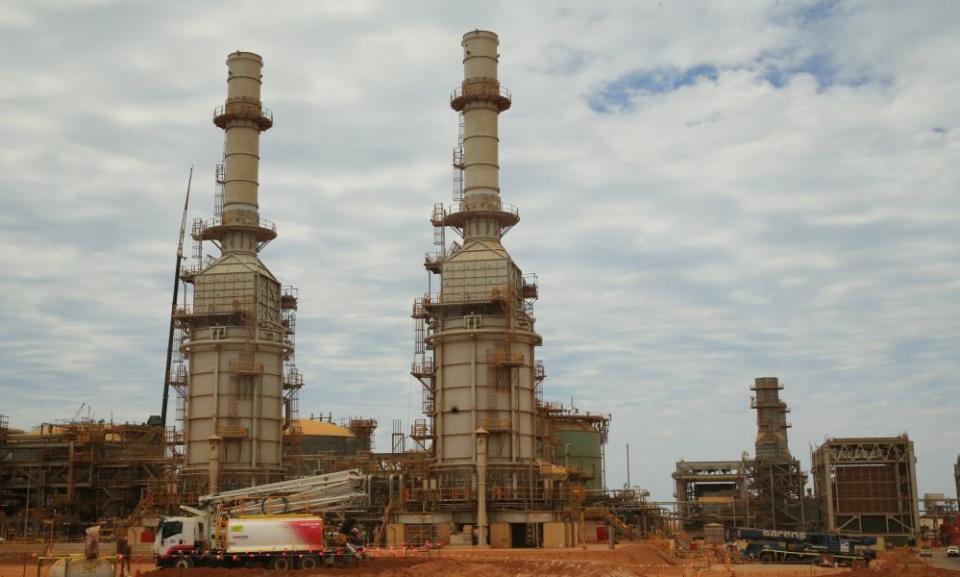Industrial emissions set to rise for another decade despite Coalition's pledge to cut carbon pollution

Australia’s skyrocketing industrial greenhouse gas emissions are projected to increase by 77% between 2005 and 2030, the period over which the Coalition has promised to cut national carbon pollution.
RepuTex, an energy and climate change analyst firm, examined government data and found total emissions from the 200 largest industrial emitters – including mines, oil and gas production, manufacturers and waste facilities – was forecast to keep rising for at least another decade.
It blames most of the expected increase on the growth of the liquified natural gas (LNG) industry, which uses large amounts of energy to extract and compress gas before it is exported, and the government’s resistance to using its “safeguard mechanism” policy to limit industrial emissions as it was intended.
RepuTex’s executive director, Hugh Grossman, said emissions from electricity generation were falling as more renewable energy came into the system, but Australia would miss its 2030 climate target submitted under the Paris agreement unless it dealt with other parts of the economy.
“Industry emissions are the elephant in the room for Australian policymakers. While we are seeing rapid decarbonisation in the electricity sector, those gains are being eroded,” Grossman said.
The report projects that national emissions will be only 16% below 2005 levels by 2030 – a slight dip below where they are now. The Morrison government has promised a minimum 26% cut. The Climate Change Authority found Australia’s fair share under a deal to address the climate crisis would be a 45-60% reduction.
Grossman said Australian industry could reach net zero emissions as early as 2038 by cutting emissions from the sector by up to 8m tonnes a year. The annual task would double if nothing is done over the next decade.
RepuTex found the government’s existing policies, including the recently announced low-emissions technology statement, would not be enough to drive a transition to net zero emissions by 2050, as scientists have recommended.
The roadmap sets “stretch goals” for reducing the cost of five technologies – “clean” hydrogen, carbon capture and storage, energy storage, soil carbon, and low-carbon steel and aluminium – but does not include timeframes or emissions reductions targets. RepuTex said some of the technologies proposed were not expected to be commercially viable until 2030 or 2040.
Related: Climate at a crossroads as Trump and Biden point in different directions
It said an “industry emissions target”, requiring an annual reduction across big emitting facilities, was the best way to address what would soon be the major source of Australia’s emissions.
Grossman said increasing international pressure, with China, Europe, Japan and – depending on the result of the presidential election – possibly the US promising to do more to combat the climate crisis than before coronavirus struck, could force Australia to act faster than expected.
If Joe Biden becomes US president, more than 70% of Australia’s two-way trade will be with countries pushing for net zero emissions by or near mid-century.
“This could be a saving grace for high emitting facilities, with an earlier start point translating into a shallower emissions reduction trajectory and … lower costs for industry,” Grossman said.
Japan, the biggest market for Australia’s thermal coal and gas, this week announced a target of net zero emissions by 2050. The new Japanese prime minister, Yoshihide Suga, said responding to the climate crisis was no longer a constraint on economic growth and promised to back clean solutions and unwind its reliance on coal.
The Morrison government has rejected the 2050 target. Its policy is to achieve net zero emissions in the second half of the century, which it says is consistent with the Paris agreement.
Many climate experts, and a growing number of national governments, disagree on the grounds the agreement says commitments should be informed by the latest climate science and countries will pursue efforts to limit global heating to 1.5C above pre-industrial levels.
The Intergovernmental Panel on Climate Change found, in a report commissioned in Paris, that global emissions would need to be 45% below 2010 levels by 2030 and reach net zero by 2050 to limit heating to 1.5C. It found staying within 2C heating would require net zero by 2070, but the environmental and social impacts would be significantly worse.
While some leaders emphasise the need to spend heavily on clean solutions – Biden, for instance, has pledged $2tn over four years if he claims office – the Australian government argues technological process is the only way to achieve net zero it while keeping economies strong.

